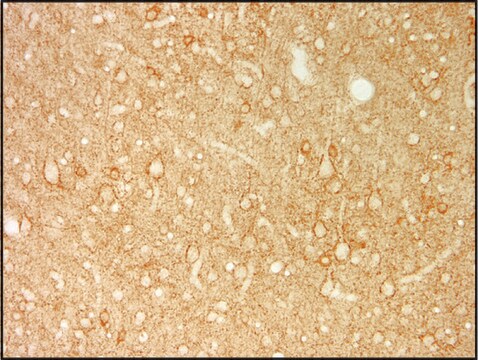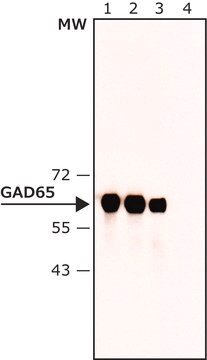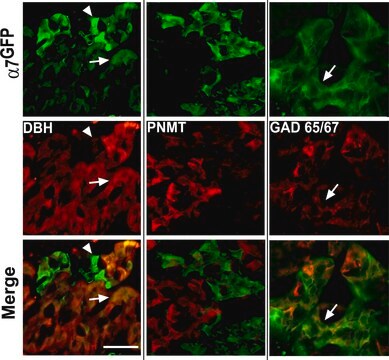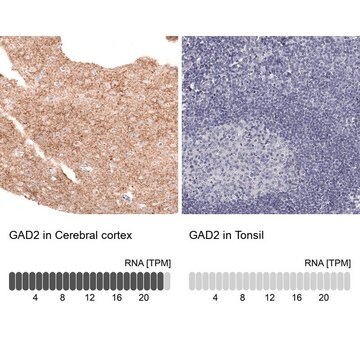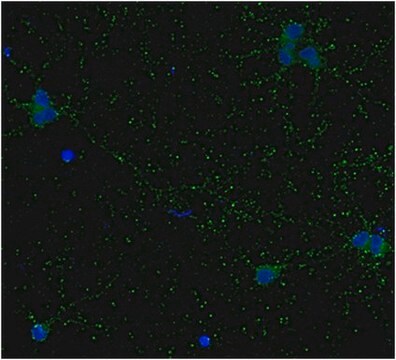G1166
Monoclonal Anti-Glutamic Acid Decarboxylase 65 antibody produced in mouse
clone GAD-6, purified immunoglobulin, buffered aqueous solution
Synonym(s):
Anti-GAD 65
Sign Into View Organizational & Contract Pricing
All Photos(1)
About This Item
Recommended Products
biological source
mouse
Quality Level
conjugate
unconjugated
antibody form
purified immunoglobulin
antibody product type
primary antibodies
clone
GAD-6, monoclonal
form
buffered aqueous solution
species reactivity
mammals (and some lower vertebrates)
technique(s)
immunohistochemistry: 1:100-1:500
western blot: 1:1,000-1:5,000
isotype
IgG2a
shipped in
dry ice
storage temp.
−20°C
target post-translational modification
unmodified
Gene Information
human ... GAD2(2572)
mouse ... Gad2(14417)
Specificity
Recognizes the lower molecular weight isoform of the two GAD isoforms identified in brain, GAD 65. Can be used for immunochemical localization of GABA secreting neurons.
Immunogen
purified rat brain GAD 65.
Physical form
Solution in 0.01 M phosphate buffered saline, containing 0.04% sodium azide.
Preparation Note
Purified using Protein A chromatography.
Disclaimer
Unless otherwise stated in our catalog or other company documentation accompanying the product(s), our products are intended for research use only and are not to be used for any other purpose, which includes but is not limited to, unauthorized commercial uses, in vitro diagnostic uses, ex vivo or in vivo therapeutic uses or any type of consumption or application to humans or animals.
Not finding the right product?
Try our Product Selector Tool.
Storage Class Code
12 - Non Combustible Liquids
WGK
WGK 1
Flash Point(F)
Not applicable
Flash Point(C)
Not applicable
Choose from one of the most recent versions:
Already Own This Product?
Find documentation for the products that you have recently purchased in the Document Library.
Gregory J Brewer et al.
Frontiers in neural circuits, 7, 165-165 (2013-10-25)
The mammalian hippocampus functions to encode and retrieve memories by transiently changing synaptic strengths, yet encoding in individual subregions for transmission between regions remains poorly understood. Toward the goal of better understanding the coding in the trisynaptic pathway from the
M Esclapez et al.
The Journal of neuroscience : the official journal of the Society for Neuroscience, 14(3 Pt 2), 1834-1855 (1994-03-01)
Two isoforms of glutamic acid decarboxylase (GAD67 and GAD65) and their mRNAs were localized in the rat brain by immunohistochemistry and nonradioactive in situ hybridization methods with digoxigenin-labeled cRNA probes. In most brain regions, both GAD isoforms were present in
Seung T Lim et al.
The Journal of comparative neurology, 507(2), 1228-1244 (2008-01-09)
Nectins are cell adhesion molecules that, together with the intracellular binding partner afadin, mediate adhesion and signaling at a variety of intercellular junctions. In this work we studied the distribution of nectin-1 and afadin during hippocampal synapse formation using cultured
Ran-Sook Woo et al.
Neuron, 54(4), 599-610 (2007-05-25)
Neuregulin-1 (NRG1), a regulator of neural development, has been shown to regulate neurotransmission at excitatory synapses. Although ErbB4, a key NRG1 receptor, is expressed in glutamic acid decarboxylase (GAD)-positive neurons, little is known about its role in GABAergic transmission. We
Stathis S Leondopulos et al.
Journal of neural engineering, 9(2), 026015-026015 (2012-03-01)
Slow wave oscillations in the brain are essential for coordinated network activity but have not been shown to self-organize in vitro. Here, the development of dissociated hippocampal neurons into an active network with oscillations on multi-electrode arrays was evaluated in
Our team of scientists has experience in all areas of research including Life Science, Material Science, Chemical Synthesis, Chromatography, Analytical and many others.
Contact Technical Service